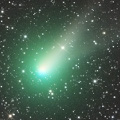
|
Now it is bright as 6.4 mag (Aug. 28, Marco Goiato). It is expected to brighten up to 4-5 mag from autumn to winter. It keeps observable in excellent condition until autumn in the Southern Hemisphere. In the Northern Hemisphere, it keeps unobservable until late November.
Date(TT) R.A. (2000) Decl. Delta r Elong. m1 Best Time(A, h)
Aug. 29 15 49.82 -63 37.2 1.171 1.604 94 6.5 19:02 ( 21, 58)
Sept. 5 15 16.26 -56 51.0 1.252 1.511 83 6.4 19:07 ( 39, 54)
|

|
It will pass the perihelion on Sept. 4. But it is not observable from the ground because it locates too close to the Sun.
Date(TT) R.A. (2000) Decl. Delta r Elong. m1 Best Time(A, h)
Aug. 29 11 25.06 -0 59.5 0.895 0.315 17 13.6 19:02 ( 88, -1)
Sept. 5 10 44.36 8 52.5 1.075 0.084 2 7.4 4:50 (271,-17)
|

|
It approached to the sun down to 0.3 a.u. on July 6, and brighted up to 3.9 mag (July 6, Thomas Lehmann). Now it is 9.5 mag (Aug. 20, Marco Goiato). In the Northern Hemisphere, it keeps observable until the comet fades out. It will not be observable after this in the Northern Hemisphere.
Date(TT) R.A. (2000) Decl. Delta r Elong. m1 Best Time(A, h)
Aug. 29 12 24.42 -33 16.4 1.693 1.318 51 10.4 19:02 ( 67, 29)
Sept. 5 12 48.75 -37 4.8 1.833 1.445 51 11.0 19:07 ( 63, 29)
|

|
It brightened up to 3.7 mag and became a naked eye comet in mid January (Jan. 13, Marek Biely). Now it is fading. But it is bright as 10.1 mag still now (Aug. 18, Juan Jose Gonzalez). In the Northern Hemisphere, it keeps observable for a long time until the comet fades out. It locates extremely low in the Southern Hemisphere, and it will be unobservable in late September.
Date(TT) R.A. (2000) Decl. Delta r Elong. m1 Best Time(A, h)
Aug. 29 15 40.32 45 16.5 3.220 3.113 74 10.7 19:02 (161, 6)
Sept. 5 15 47.68 42 30.7 3.329 3.186 73 10.9 19:07 (155, 7)
|
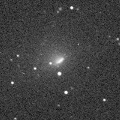
|
Now it is 11.7 mag (Aug. 7, Marco Goiato). It will brighten up to 11 mag autumn. In this apparition, it is observable until the highlight while the comet is brightening.
Date(TT) R.A. (2000) Decl. Delta r Elong. m1 Best Time(A, h)
Aug. 29 14 22.73 -10 43.7 1.879 1.661 61 11.3 19:02 (108, 41)
Sept. 5 14 39.27 -12 21.2 1.903 1.639 59 11.2 19:07 (103, 39)
|
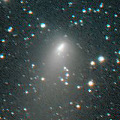
|
It brightened rapidly up to 10.4 mag from July to August (July 18, Maik Meyer). Now it is fading, but it is bright as 11.3 mag still now (Aug. 21, Uwe Pilz). It is observable in good condition in the Northern Hemisphere, but it will be getting lower gradually in the Southern Hemisphere.
Date(TT) R.A. (2000) Decl. Delta r Elong. m1 Best Time(A, h)
Aug. 29 18 52.15 41 46.1 1.034 1.662 108 11.5 20:22 (180, 13)
Sept. 5 18 48.09 43 3.6 1.101 1.678 105 11.8 19:51 (180, 12)
|
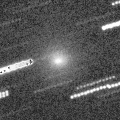
|
It brightened rapidly in mid August. Now it is very bright as 11.2 mag (Aug. 28, Juan Jose Gonzalez). Secondary component is also visible as 14.0 mag (Aug. 28, Michael Jager). In the Northern Hemisphere, it keeps observable in good condition in the morning sky. It keeps locating extremely low from summer to autumn.
Date(TT) R.A. (2000) Decl. Delta r Elong. m1 Best Time(A, h)
Aug. 29 7 33.73 25 25.0 1.021 0.764 44 11.8 5:00 (233, 6)
Sept. 5 8 4.62 21 51.7 1.104 0.783 43 11.8 4:50 (238, 6)
|
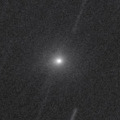
|
New bright comet. Now it is 11.6 mag (Aug. 18, Chris Wyatt). In the Southern Hemisphere, it keeps observable in the evening sky until the comet becomes fainter than 18 mag in winter. In the Northern Hemisphere, it will never be observable again.
Date(TT) R.A. (2000) Decl. Delta r Elong. m1 Best Time(A, h)
Aug. 29 13 41.42 -22 6.8 0.993 0.957 57 11.8 19:02 ( 88, 39)
Sept. 5 14 6.01 -31 25.1 1.083 1.047 59 12.4 19:07 ( 76, 41)
|
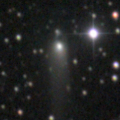
|
Now it is 11.8 mag (Aug. 26, Katsumi Yoshimoto). It keeps bright as 12 mag from August to October. In the Northern Hemisphere, it is getting higher gradually, and it keeps observable in good condition after this. In the Southern Hemisphere, it keeps low until November.
Date(TT) R.A. (2000) Decl. Delta r Elong. m1 Best Time(A, h)
Aug. 29 7 32.77 24 2.2 1.769 1.259 44 12.2 5:00 (234, 7)
Sept. 5 7 59.25 23 26.6 1.774 1.275 44 12.2 4:50 (236, 6)
|
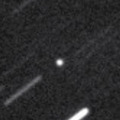
|
Now it is faint as 16.8 mag (Aug. 18, J. Oey, P. Camilleri, H. Williams). It will brighten very rapidly after this. It will brighten up to 11 mag from autumn to winter. But it locates low at that time.
Date(TT) R.A. (2000) Decl. Delta r Elong. m1 Best Time(A, h)
Aug. 29 15 4.97 -10 12.6 1.632 1.627 71 13.1 19:02 (118, 49)
Sept. 5 15 19.28 -12 6.3 1.652 1.594 68 12.8 19:07 (111, 47)
|
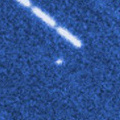
|
It brightened up to 12.8 mag until March (Mar. 21, Michael Mattiazzo). It must have brightened up to 10.5 mag in May and June, but it was not observable. In the Northern Hemisphere, it will be observable after autumn while the comet will be fading.
Date(TT) R.A. (2000) Decl. Delta r Elong. m1 Best Time(A, h)
Aug. 29 9 45.81 30 30.4 2.586 1.703 23 12.9 5:00 (246,-20)
Sept. 5 10 6.84 29 47.3 2.608 1.749 25 13.1 4:50 (247,-21)
|

|
It is fading, but bright as 11.4 mag still now (Aug. 21, Uwe Pilz). It keeps observable in good condition until winter when the comet becomes fainter than 18 mag.
Date(TT) R.A. (2000) Decl. Delta r Elong. m1 Best Time(A, h)
Aug. 29 2 55.70 12 37.2 1.429 2.011 109 13.1 4:29 (180, 42)
Sept. 5 2 56.76 12 44.4 1.400 2.057 116 13.3 4:03 (180, 42)
|
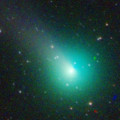
|
It brightened up to 6.0 mag in mid May (May 14, Chris Wyatt). Now it is fading. It has faded down to 9.0 mag in late June (June 21, Marco Goiato). It is appearing in the morning sky. In the Northern Hemisphere, it keeps observable in good condition after this while the comet will be fading. It locates somewhat low in the Southern Hemisphere.
Date(TT) R.A. (2000) Decl. Delta r Elong. m1 Best Time(A, h)
Aug. 29 8 38.29 17 12.3 2.692 1.858 27 13.3 5:00 (249, 0)
Sept. 5 8 40.18 17 58.7 2.703 1.953 34 13.6 4:50 (246, 2)
|
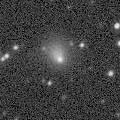
|
Now it is 13.7 mag (Aug. 26, Hiroshi Abe). It will pass close to the earth from spring to summer in 2016, and it is expected to be observable at 6-7 mag in good condition. In the Northern Hemispehre, it will be getting higher gradually in the morning sky, then it keeps observable in excellent condition until winter. In the Southern Hemisphere, it keeps very low until winter.
Date(TT) R.A. (2000) Decl. Delta r Elong. m1 Best Time(A, h)
Aug. 29 5 45.17 37 9.8 3.603 3.372 68 13.6 5:00 (208, 11)
Sept. 5 5 45.27 37 47.4 3.406 3.300 75 13.3 4:50 (204, 12)
|

|
Now it is 12.9 mag (July 11, Gabor Santa). In 2015, it keeps 13-14 mag and will be observable in good condition for a long time.
Date(TT) R.A. (2000) Decl. Delta r Elong. m1 Best Time(A, h)
Aug. 29 19 9.68 -12 10.2 2.958 3.703 131 13.5 20:41 (180, 67)
Sept. 5 19 11.02 -12 37.4 3.055 3.727 125 13.6 20:15 (180, 68)
|

|
It brightened in outburst twice in July. It is bright as 12.1 mag still now (Aug. 10, Chris Wyatt).
Date(TT) R.A. (2000) Decl. Delta r Elong. m1 Best Time(A, h)
Aug. 29 17 16.52 -29 50.4 5.667 6.013 105 13.6 19:02 (149, 84)
Sept. 5 17 17.71 -29 40.4 5.773 6.011 98 13.6 19:07 (116, 79)
|
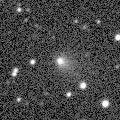
|
Now it is 13.8 mag and visible visually (Aug. 13, Sandor Szabo). It is expected to brighten up to 15 mag from autum to next spring, and to be observable in excellent condition in the Northern Hemisphere. It keeps unobservable in the Southern Hemisphere.
Date(TT) R.A. (2000) Decl. Delta r Elong. m1 Best Time(A, h)
Aug. 29 2 58.92 64 36.5 2.188 2.418 90 14.1 4:33 (180,-10)
Sept. 5 3 5.17 69 0.7 2.109 2.379 92 13.9 4:12 (180,-14)
|

|
Now it is 14.1 mag and visible visually (July 10, Jakub Cerny). Distant object, but it keeps observable at 14-15 mag for a long time from 2015 to 2016.
Date(TT) R.A. (2000) Decl. Delta r Elong. m1 Best Time(A, h)
Aug. 29 21 15.34 -3 15.0 4.298 5.263 160 14.4 22:46 (180, 58)
Sept. 5 21 13.38 -3 46.4 4.314 5.245 154 14.4 22:16 (180, 59)
|
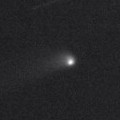
|
Now it is 15.4 mag (Aug. 26, D. Buczynski). It will brighten up to 14 mag from 2015 to 2016. It keeps observable in good condition for a while.
Date(TT) R.A. (2000) Decl. Delta r Elong. m1 Best Time(A, h)
Aug. 29 2 56.21 12 16.8 3.728 4.181 109 14.6 4:30 (180, 43)
Sept. 5 2 49.32 12 48.1 3.610 4.180 118 14.5 3:56 (180, 42)
|

|
Now it is 14.7 mag (Aug. 26, Hiroshi Abe). It keeps 13 mag for a long time from 2015 autumn to 2016 summer. In the Northern Hemispehre, it keeps observable in good condition for a long time. It keeps unobservable in the Southern Hemisphere.
Date(TT) R.A. (2000) Decl. Delta r Elong. m1 Best Time(A, h)
Aug. 29 6 18.09 52 9.4 3.624 3.338 65 14.7 5:00 (205, -5)
Sept. 5 6 28.24 54 11.3 3.493 3.297 70 14.6 4:50 (203, -6)
|

|
First return of a periodic comet discovered in 1994. Now it is 15.8 mag (Aug. 22, K. Hills). It will brighten up to 15 mag from summer to autumn, and will be observable in excellent condition in the Southern Hemisphere. It locates somewhat low in the Northern Hemisphere.
Date(TT) R.A. (2000) Decl. Delta r Elong. m1 Best Time(A, h)
Aug. 29 22 52.95 -35 56.3 1.554 2.497 153 14.9 0:27 ( 0, 89)
Sept. 5 22 48.07 -35 40.7 1.553 2.485 151 14.9 23:50 ( 0, 89)
|

|
Now it is 14.9 mag (Aug. 26, D. Buczynski). It keeps 15 mag for a long time from 2014 to 2015. It is observable in excellent condition in the Northern Hemisphere. It locates low in the Southern Hemisphere.
Date(TT) R.A. (2000) Decl. Delta r Elong. m1 Best Time(A, h)
Aug. 29 2 19.44 37 48.2 3.722 4.149 108 15.0 3:53 (180, 17)
Sept. 5 2 15.82 39 19.4 3.656 4.171 114 15.0 3:22 (180, 16)
|

|
It brightened very rapidly, and brightened up to 13.8 mag (May 11, Sandor Szabo). It is not observable now. It will appear in the morning sky in November, but it will be fainter than 17 mag.
Date(TT) R.A. (2000) Decl. Delta r Elong. m1 Best Time(A, h)
Aug. 29 11 12.51 -4 15.1 4.418 3.470 17 15.3 19:02 ( 84, -1)
Sept. 5 11 21.84 -5 20.4 4.446 3.478 14 15.4 19:07 ( 80, -5)
|

|
Now it is 16.3 mag (Aug. 24, S. Shurpakov). It will be observable at 15 mag in good condition in autumn.
Date(TT) R.A. (2000) Decl. Delta r Elong. m1 Best Time(A, h)
Aug. 29 2 21.86 9 37.4 1.452 2.130 118 15.6 3:55 (180, 45)
Sept. 5 2 26.97 9 27.8 1.386 2.124 124 15.5 3:33 (180, 45)
|
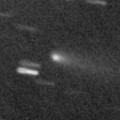
|
Now it is 14.6 mag and visible visually (July 12, Jakub Cerny). It will be observable in excellent condition at 14-15 mag in summer.
Date(TT) R.A. (2000) Decl. Delta r Elong. m1 Best Time(A, h)
Aug. 29 0 31.78 5 5.7 1.026 1.946 145 15.5 2:06 (180, 50)
Sept. 5 0 28.91 4 31.8 1.020 1.974 153 15.7 1:35 (180, 50)
|

|
It brightened up to 6.9 mag in 2014 autumn (Oct. 17, Marco Goiato). Now it is fading. It has already faded down to 16.2 mag (Aug. 22, K. Hills). In the Southern Hemisphere, it keeps observable in good condition until the comet fades out. In the Northern Hemisphere, it keeps observable until winter, but it locates somewhat low.
Date(TT) R.A. (2000) Decl. Delta r Elong. m1 Best Time(A, h)
Aug. 29 23 55.41 -26 58.1 3.877 4.800 153 15.6 1:30 (180, 82)
Sept. 5 23 45.89 -27 40.7 3.930 4.868 155 15.6 0:53 (180, 83)
|

|
Now it is 15.8 mag (Aug. 5, Ken-ichi Kadota). It keeps 15-16 mag for a long time until 2016. It keeps observable in excellent condition in the Northern Hemisphere. It keeps unobservable in the Southern Hemisphere.
Date(TT) R.A. (2000) Decl. Delta r Elong. m1 Best Time(A, h)
Aug. 29 5 21.47 54 47.0 5.373 5.194 74 15.8 5:00 (196, -3)
Sept. 5 5 26.20 56 10.1 5.279 5.191 79 15.8 4:50 (194, -4)
|

|
It brightened up to 13 mag in 2014. Now it is 16.3 mag (Aug. 27, A. Maury, J.-G. Bosch, J.-F. Soulier, T. Noel). It will be fading slowly after this. It is observable at 16 mag in excellent condition from summer to winter in 2015.
Date(TT) R.A. (2000) Decl. Delta r Elong. m1 Best Time(A, h)
Aug. 29 1 40.45 2 2.4 3.108 3.843 130 16.0 3:14 (180, 53)
Sept. 5 1 38.56 1 47.7 3.052 3.859 137 16.0 2:45 (180, 53)
|
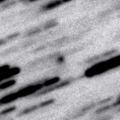
|
It brightened up to 16.4 mag in 2014 (Nov. 14, J. F. Hernandez). Now it is 17.2 mag (Aug. 27, D. Buczynski). It will be observable at 16 mag again from summer to autumn in 2015. However, it is fainter than this ephemeris recently.
Date(TT) R.A. (2000) Decl. Delta r Elong. m1 Best Time(A, h)
Aug. 29 4 4.82 26 54.9 2.193 2.426 90 16.2 5:00 (190, 27)
Sept. 5 4 11.64 27 20.6 2.133 2.451 95 16.1 4:50 (187, 27)
|

|
Now it is 15.1 mag (July 13, Yuji Ohshima). It is observable at 15-16 mag in good condition until autumn. It locates somewhat low in the Northern Hemisphere.
Date(TT) R.A. (2000) Decl. Delta r Elong. m1 Best Time(A, h)
Aug. 29 17 39.24 -25 32.9 7.801 8.204 110 16.2 19:10 (180, 81)
Sept. 5 17 37.33 -25 47.7 7.950 8.235 102 16.2 19:07 (147, 79)
|
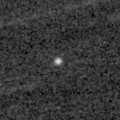
|
Now it is 17.1mag (Aug. 27, A. Maury, J.-G. Bosch, J.-F. Soulier, T. Noel). It is expected to brighten rapidly, and to be observable at 14.5 mag in good condition in autumn.
Date(TT) R.A. (2000) Decl. Delta r Elong. m1 Best Time(A, h)
Aug. 29 3 19.90 -5 0.7 1.104 1.706 107 16.5 4:53 (180, 60)
Sept. 5 3 34.79 -5 27.1 1.033 1.673 110 16.3 4:40 (180, 60)
|

|
Now it is 15.9 mag (Aug. 20, Catalina Sky Survey). It is fading, but it is observable at 17 mag in good condition until late autumn. The fragments B and C are already fainter than 20 mag (June 12, Takaaki Oribe).
Date(TT) R.A. (2000) Decl. Delta r Elong. m1 Best Time(A, h)
Aug. 29 23 15.32 5 57.8 5.346 6.307 160 16.8 0:50 (180, 49)
Sept. 5 23 10.22 4 58.1 5.366 6.353 167 16.9 0:17 (180, 50)
|

|
No observations have been reported after November in 2014. Current brightness is uncertain. It must keep 16 mag for a long time from 2015 autumn to 2016 summer. It keeps observable in excellent condition in the Southern Hemisphere. It locates low in the Northern Hemisphere.
Date(TT) R.A. (2000) Decl. Delta r Elong. m1 Best Time(A, h)
Aug. 29 3 12.96 -12 44.5 2.621 3.118 110 17.0 4:47 (180, 68)
Sept. 5 3 5.51 -15 48.1 2.476 3.078 117 16.9 4:12 (180, 71)
|

|
Now it is 17.5 mag (July 25, Katsumi Yoshimoto). It has brightened in outburst up to 14 mag twice, in 2006 January and 2011 May. It is around the perihelion now. It keeps observable at 17 mag for a long time after this.
Date(TT) R.A. (2000) Decl. Delta r Elong. m1 Best Time(A, h)
Aug. 29 23 20.89 -3 35.8 4.866 5.850 165 17.0 0:55 (180, 58)
Sept. 5 23 18.45 -3 54.7 4.851 5.853 172 16.9 0:25 (180, 59)
|
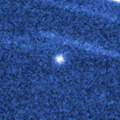
|
Now it is 16.3 mag (Aug. 22, E. Bryssinck). In the Northern Hemisphere, it is getting higher gradually in the morning sky. It is not observable in the Southern Hemisphere.
Date(TT) R.A. (2000) Decl. Delta r Elong. m1 Best Time(A, h)
Aug. 29 7 1.75 35 49.2 1.692 1.360 53 17.0 5:00 (221, 3)
Sept. 5 7 27.65 37 1.5 1.695 1.395 55 17.1 4:50 (221, 1)
|

|
Now it is 18.3 mag (Aug. 18, Jean-Francois Soulier). It will be observable at 17 mag in good condition from summer to autumn.
Date(TT) R.A. (2000) Decl. Delta r Elong. m1 Best Time(A, h)
Aug. 29 23 44.14 -5 5.7 1.521 2.496 160 17.4 1:18 (180, 60)
Sept. 5 23 41.83 -5 41.5 1.494 2.489 167 17.2 0:48 (180, 61)
|

|
Now it is 16.0 mag (Aug. 20, Catalina Sky Survey). It keeps observable in good condition until the comet fades out. In 2014, it must have been observable at 14 mag in good condition in the Southern Hemisphere.
Date(TT) R.A. (2000) Decl. Delta r Elong. m1 Best Time(A, h)
Aug. 29 0 41.34 2 9.7 3.258 4.124 144 17.2 2:15 (180, 53)
Sept. 5 0 37.08 2 17.6 3.255 4.175 152 17.3 1:44 (180, 53)
|

|
First return of a periodic comet discovered in 2008. It approached to the earth and brightened up to 16 mag from spring to summer (June 2, WISE). Now it is fading. It has already faded down to 17.9 mag (Aug. 13, W. Hasubick).
Date(TT) R.A. (2000) Decl. Delta r Elong. m1 Best Time(A, h)
Aug. 29 3 43.47 -7 39.5 0.783 1.402 102 17.2 5:00 (189, 62)
Sept. 5 3 50.49 -8 28.4 0.791 1.448 106 17.4 4:50 (183, 63)
|

|
No observations have been reported after November in 2014. It will brighten up to 11 mag from spring to summer in 2016. In the Northern Hemisphere, it keeps observable in good condition while the comet will be brightening. It locates somewhat low in the Southern Hemisphere.
Date(TT) R.A. (2000) Decl. Delta r Elong. m1 Best Time(A, h)
Aug. 29 5 23.77 20 12.3 3.278 3.148 73 17.6 5:00 (211, 28)
Sept. 5 5 31.07 20 13.9 3.145 3.110 78 17.4 4:50 (209, 29)
|

|
Now it is 16.5 mag (Aug. 8, J. Oey, P. Camilleri, H. Williams). It keeps observable at 17 mag from spring to summer. It locates somewhat low in the Northern Hemisphere.
Date(TT) R.A. (2000) Decl. Delta r Elong. m1 Best Time(A, h)
Aug. 29 16 49.84 -22 29.2 2.972 3.280 98 17.5 19:02 (142, 75)
Sept. 5 16 54.96 -22 22.3 3.078 3.290 93 17.6 19:07 (126, 71)
|
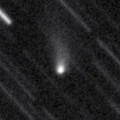
|
It brightened up to 15.3 mag in winter (Jan. 17, Taras Prystavski). Now it is fading. It has already faded down to 16.6 mag (Aug. 18, Catalina Sky Survey). It keeps observable in good condition for a while. But it will be fainter than 18 mag in September.
Date(TT) R.A. (2000) Decl. Delta r Elong. m1 Best Time(A, h)
Aug. 29 21 58.79 -11 26.0 1.920 2.925 172 17.5 23:28 (180, 66)
Sept. 5 21 40.78 -10 37.1 2.007 2.981 161 17.7 22:42 (180, 65)
|
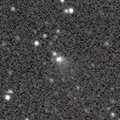
|
It brightened up to 15.6 mag from spring to summer (July 8, Taras Prystavski). Now it is fading. It has already faded down to 16.8 mag (Aug. 21, B. Haeusler). It will be fainter than 18 mag in September.
Date(TT) R.A. (2000) Decl. Delta r Elong. m1 Best Time(A, h)
Aug. 29 17 23.43 -8 19.7 1.266 1.812 104 17.6 19:02 (176, 63)
Sept. 5 17 35.91 -8 47.0 1.336 1.828 101 17.7 19:07 (165, 63)
|

|
It has not been recovered yet. But it must be already bright as 18 mag. It will approach to the earth from autumn to winter, and it is expected to brighten up to 15 mag and observable in excellent condition.
Date(TT) R.A. (2000) Decl. Delta r Elong. m1 Best Time(A, h)
Aug. 29 3 48.07 -7 20.0 1.504 1.965 100 17.8 5:00 (191, 62)
Sept. 5 3 59.72 -7 15.0 1.415 1.927 104 17.6 4:50 (188, 62)
|
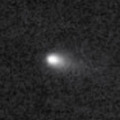
|
It brightened up to 15.9 mag in June as predicted (June 23, Ken-ichi Kadota). It was expected to be observable at 13 mag in good condition from summer to autumn. However, Jean-Gabriel Bosch detected the comet became disintegrating in July. Now it is so faint as 19.3 mag (Aug. 26, W. Hasubick). The fragment D and B are also observed as 19.4 mag (July 28, iTelescope Observatory, Siding Spring) and 20.9 mag (Aug. 21, Pan-STARRS 1, Haleakala) respectively.
Date(TT) R.A. (2000) Decl. Delta r Elong. m1 Best Time(A, h)
Aug. 29 2 11.90 2 49.1 0.933 1.707 122 17.7 3:45 (180, 52)
Sept. 5 2 18.18 3 3.8 0.899 1.715 127 17.6 3:24 (180, 52)
|

|
Now it is 17.8 mag (Aug. 19, A. Diepvens). It was observed at 17 mag in 2014 summer. In the Northern Hemisphere, it is observable at 17.5 mag in excellent condition also in 2015. It is not observable in the Southern Hemisphere.
Date(TT) R.A. (2000) Decl. Delta r Elong. m1 Best Time(A, h)
Aug. 29 21 58.71 53 21.0 4.035 4.578 116 17.6 23:29 (180, 2)
Sept. 5 21 55.13 52 26.5 4.034 4.610 119 17.7 22:57 (180, 3)
|
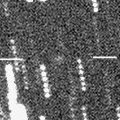
|
Now it is 18.8 mag (Aug. 10, A. Sodor, K. Sarneczky). It was predicted to be observable at 17.5 mag in good condition from autumn to winter, but it is a bit fainter actually.
Date(TT) R.A. (2000) Decl. Delta r Elong. m1 Best Time(A, h)
Aug. 29 18 14.24 21 5.9 1.274 1.883 110 17.8 19:45 (180, 34)
Sept. 5 18 18.18 17 56.2 1.271 1.847 107 17.7 19:22 (180, 37)
|
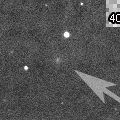
|
Fading rapidly. Now it is 16.0 mag (July 26, Ken-ichi Kadota). It will be fainter than 18 mag in late August.
Date(TT) R.A. (2000) Decl. Delta r Elong. m1 Best Time(A, h)
Aug. 29 5 17.16 3 34.4 2.309 2.307 77 17.7 5:00 (220, 43)
Sept. 5 5 24.18 3 0.2 2.275 2.357 81 18.2 4:50 (217, 45)
|
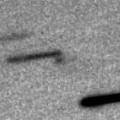
|
Now it is 17.8 mag (Aug. 14, Space Surveillance Telescope, Atom Site). It will be observable at 17.5 mag in good condition in summer.
Date(TT) R.A. (2000) Decl. Delta r Elong. m1 Best Time(A, h)
Aug. 29 3 17.93 9 19.2 1.147 1.718 105 17.8 4:51 (180, 46)
Sept. 5 3 25.63 8 53.0 1.118 1.746 110 17.9 4:31 (180, 46)
|
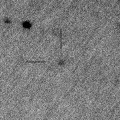
|
Now it is 18.9 mag (Aug. 25, S. Shurpakov). Now it is near the aphelion. It is observable at 17 mag in good condition from autumn to winter.
Date(TT) R.A. (2000) Decl. Delta r Elong. m1 Best Time(A, h)
Aug. 29 3 51.45 16 26.6 4.154 4.374 95 17.9 5:00 (188, 38)
Sept. 5 3 53.47 16 31.9 4.041 4.366 102 17.8 4:50 (183, 38)
|
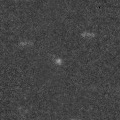
|
Now it is 17.1 mag (Aug. 23, E. Bryssinck). It was expected to brighten rapidly, and to be observable at 16 mag in good condition from summer to winter. But actually, it is much fainter than predicted.
Date(TT) R.A. (2000) Decl. Delta r Elong. m1 Best Time(A, h)
Aug. 29 23 19.15 -13 28.8 1.390 2.385 166 18.0 0:54 (180, 68)
Sept. 5 23 11.96 -13 5.9 1.348 2.352 172 17.9 0:19 (180, 68)
|

|
It will brighten up to 14 mag in 2016 summer. But it is not observable at the highlight. It keeps observable until March while the comet will be brightening gradually up to 15-16 mag.
Date(TT) R.A. (2000) Decl. Delta r Elong. m1 Best Time(A, h)
Aug. 29 0 57.56 -0 15.3 2.034 2.894 141 18.0 2:31 (180, 55)
Sept. 5 0 55.61 -0 56.7 1.952 2.864 148 17.9 2:02 (180, 56)
|

|
Far object. Now it is 17.3 mag (Aug. 16, J. Oey, P. Camilleri, H. Williams). It keeps observable at 18 mag in good condition from summer to autumn.
Date(TT) R.A. (2000) Decl. Delta r Elong. m1 Best Time(A, h)
Aug. 29 19 44.83 -5 13.8 5.737 6.537 139 17.9 21:16 (180, 60)
Sept. 5 19 44.13 -5 42.5 5.808 6.537 133 18.0 20:47 (180, 61)
|
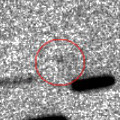
|
Now it is 19.2 mag (Aug. 26, W. Hasubick). First return of a comet re-discovered after 112-year blank in 2008. It brightened up to 12 mag in 2008. In this apparition, it was expected to brighten up to 15 mag from spring to summer, but it is much fainter than predicted.
Date(TT) R.A. (2000) Decl. Delta r Elong. m1 Best Time(A, h)
Aug. 29 4 23.69 11 22.4 1.599 1.879 89 18.1 5:00 (199, 42)
Sept. 5 4 32.86 10 30.1 1.567 1.917 93 18.2 4:50 (196, 43)
|

|
It was expected to brighten rapidly up to 15 mag in August. But actually, it is so faint as 19.7 mag, much fainter than predicted (Aug. 15, Slooh.com Canary Islands Observatory).
Date(TT) R.A. (2000) Decl. Delta r Elong. m1 Best Time(A, h)
Aug. 29 16 17.46 -8 47.2 0.195 1.025 88 18.5 19:02 (145, 59)
Sept. 5 17 35.04 -6 10.2 0.184 1.059 101 18.4 19:07 (168, 60)
|
|
![]()
 C/2014 Q1 ( PanSTARRS )
C/2014 Q1 ( PanSTARRS ) C/2014 Q2 ( Lovejoy )
C/2014 Q2 ( Lovejoy ) 22P/Kopff
22P/Kopff C/2015 F4 ( Jacques )
C/2015 F4 ( Jacques ) 141P/Machholz 2
141P/Machholz 2 C/2015 P3 ( SWAN )
C/2015 P3 ( SWAN ) 67P/Churyumov-Gerasimenko
67P/Churyumov-Gerasimenko 10P/Tempel 2
10P/Tempel 2 19P/Borrelly
19P/Borrelly 88P/Howell
88P/Howell C/2015 G2 ( MASTER )
C/2015 G2 ( MASTER ) C/2013 X1 ( PanSTARRS )
C/2013 X1 ( PanSTARRS ) C/2012 F3 ( PanSTARRS )
C/2012 F3 ( PanSTARRS ) 29P/Schwassmann-Wachmann 1
29P/Schwassmann-Wachmann 1 C/2014 S2 ( PanSTARRS )
C/2014 S2 ( PanSTARRS ) C/2011 KP36 ( Spacewatch )
C/2011 KP36 ( Spacewatch ) C/2014 A4 ( SONEAR )
C/2014 A4 ( SONEAR ) C/2014 W2 ( PanSTARRS )
C/2014 W2 ( PanSTARRS ) 318P/2014 M6 ( McNaught-Hartley )
318P/2014 M6 ( McNaught-Hartley ) C/2014 N3 ( NEOWISE )
C/2014 N3 ( NEOWISE ) C/2014 W11 ( PanSTARRS )
C/2014 W11 ( PanSTARRS ) 61P/Shajn-Schaldach
61P/Shajn-Schaldach 57P/du Toit-Neujmin-Delporte
57P/du Toit-Neujmin-Delporte C/2012 K1 ( PanSTARRS )
C/2012 K1 ( PanSTARRS ) C/2013 V4 ( Catalina )
C/2013 V4 ( Catalina ) 117P/Helin-Roman-Alu 1
117P/Helin-Roman-Alu 1 44P/Reinmuth 2
44P/Reinmuth 2 C/2010 S1 ( LINEAR )
C/2010 S1 ( LINEAR ) 230P/LINEAR
230P/LINEAR C/2011 J2 ( LINEAR )
C/2011 J2 ( LINEAR ) C/2014 W5 ( Lemmon-PanSTARRS )
C/2014 W5 ( Lemmon-PanSTARRS ) 174P/(60558) 2000 EC98 ( Echeclus )
174P/(60558) 2000 EC98 ( Echeclus ) 162P/Siding Spring
162P/Siding Spring 151P/Helin
151P/Helin C/2015 K1 ( MASTER )
C/2015 K1 ( MASTER ) 319P/2015 G1 ( Catalina-McNaught )
319P/2015 G1 ( Catalina-McNaught ) 81P/Wild 2
81P/Wild 2 299P/2014 D2 ( Catalina-PanSTARRS )
299P/2014 D2 ( Catalina-PanSTARRS ) C/2014 AA52 ( Catalina )
C/2014 AA52 ( Catalina ) 221P/LINEAR
221P/LINEAR P/2003 WC7 ( LINEAR-Catalina )
P/2003 WC7 ( LINEAR-Catalina ) 51P/Harrington
51P/Harrington C/2013 G3 ( PanSTARRS )
C/2013 G3 ( PanSTARRS ) 327P/2015 P2 ( Van Ness )
327P/2015 P2 ( Van Ness ) 6P/d'Arrest
6P/d'Arrest 220P/McNaught
220P/McNaught 74P/Smirnova-Chernykh
74P/Smirnova-Chernykh 50P/Arend
50P/Arend 118P/Shoemaker-Levy 4
118P/Shoemaker-Levy 4 C/2012 LP26 ( Palomar )
C/2012 LP26 ( Palomar ) 205P/Giacobini
205P/Giacobini 320P/2015 HC10 ( McNaught )
320P/2015 HC10 ( McNaught )![]()
















































